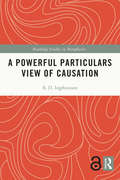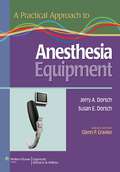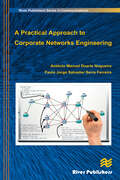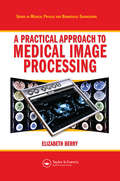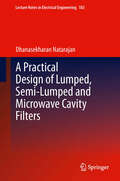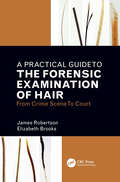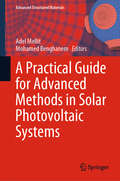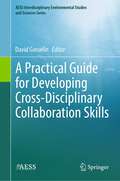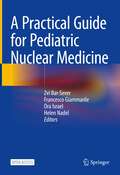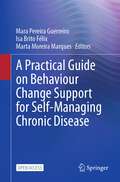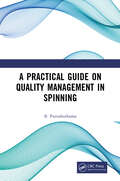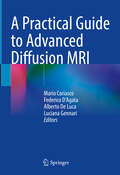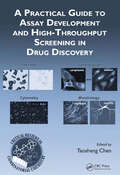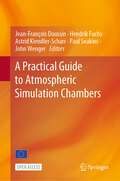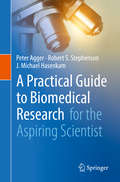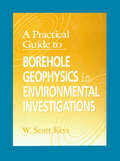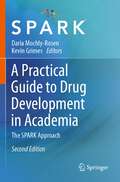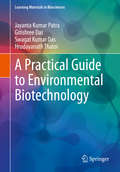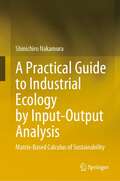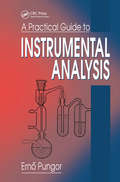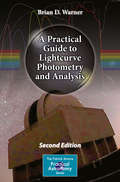- Table View
- List View
A Powerful Particulars View of Causation (Routledge Studies in Metaphysics)
by R.D. IngthorssonThis book critically examines the recent discussions of powers and powers-based accounts of causation. The author then develops an original view of powers-based causation that aims to be compatible with the theories and findings of natural science. Recently, there has been a dramatic revival of realist approaches to properties and causation, which focus on the relevance of Aristotelian metaphysics and the notion of powers for a scientifically informed view of causation. In this book, R.D. Ingthorsson argues that one central feature of powers-based accounts of causation is arguably incompatible with what is today recognised as fact in the sciences, notably that all interactions are thoroughly reciprocal. Ingthorsson’s powerful particulars view of causation accommodates for the reciprocity of interactions. It also draws out the consequences of that view for issue of causal necessity and offers a way to understand the constitution and persistence of compound objects as causal phenomena. Furthermore, Ingthorsson argues that compound entities, so understood, are just as much processes as they are substances. A Powerful Particulars View of Causation will be of great interest to scholars and advanced students working in metaphysics, philosophy of science, and neo-Aristotelian philosophy, while also being accessible for a general audience. The Open Access version of this book, available at http://www.taylorfrancis.com/books/9781003094241, has been made available under a Creative Commons Attribution-Non Commercial-No Derivatives 4.0 license.
A Practical Approach to Anesthesia Equipment
by Jerry A. Dorsch Susan E. DorschThis book is ideally suited for anesthesiologists, residents, and nurse anesthetists who need a concise, practical, easily accessible reference on anesthesia equipment. Written by the authors of the definitive text Understanding Anesthesia Equipment, A Practical Approach to Anesthesia Equipment covers the most commonly used machines and devices and addresses common problems and pitfalls that affect clinical situations. The book is written in outline format.
A Practical Approach to Corporate Networks Engineering
by Paulo Salvador Antonio NogueiraA Practical Approach to Corporate Networks Engineering is dedicated to corporate network design and engineering, covering the different levels of network design and deployment. The main theoretical concepts are explained and the different functioning mechanisms are illustrated with practical experiments. Using an open source network simulator that is able to emulate real network equipment and run concrete network scenarios (Graphical Network Simulator), the authors present several realistic network scenarios that illustrate the different network protocols and mechanisms and can be easily replicated by readers at home. Readers will be able to configure the different network equipments, run the scenarios and capture traffic at the different network links on their own, ordinary PC, acquiring a deep knowledge of the underlying network protocols and mechanisms.This interactive and practical teaching approach is very motivating and effective, since students can easily follow the explanations that are given throughout the book, making this work a valuable addition to the existing literature.
A Practical Approach to Medical Image Processing
by Elizabeth BerryThe ability to manipulate and analyze pictorial information to improve medical diagnosis, monitoring, and therapy via imaging is a valuable tool that every professional working in radiography, medical imaging, and medical physics should utilize. However, previous texts on the subject have only approached the subject from a programming or computer s
A Practical Design of Lumped, Semi-lumped & Microwave Cavity Filters (Lecture Notes in Electrical Engineering #183)
by Dhanasekharan NatarajanThis book presents the application of microwave literature for designing lumped/semi-lumped filters and combline/iris-coupled microwave cavity filters. It provides the physical understanding of the terms and characteristics of radio frequency (RF) filters. The book complements engineering text books on RF components and provides support for the project assignments of students. In addition to the functional design of RF filters, the integrated design approach for produceability and reliability is explained.
A Practical Guide To The Forensic Examination Of Hair: From Crime Scene To Court
by Elizabeth Brooks James R. RobertsonA Practical Guide to the Forensic Examination of Hair: From Crime Scene to Court presents current best practices and methodologies for forensic microscopists and trace evidence analysts, in addition to lawyers and judges, to detail the utilisation of hair evidence in court cases. The 30-year evolution and development of forensic DNA analysis has placed very heavy focus on its value in identifying the source of biological materials in other evidence. In addition to some recent controversies over the reliability of hair evidence and analysis, the question arises: what to do with hairs and hair evidence presented in court cases? The reality is that this is a fairly common form of evidence present at, and relevant in, many types of crime scenes and scenarios. Are we to simply ignore hairs as an evidence type? This book outlines the case for hair evidence’s continued relevance as a valuable biological source that can contribute to assisting in answering questions of identity and questions of what happened or the criminalistic potential of hairs. The authors present a four-level approach to the case management of recovered hairs. This system, which can be incorporated into contemporary forensic practice, stresses the need for thorough and systematic recording of hairs and their microscopic features and on the need to focus on differences to effectively triage recovered hairs. The approach focuses on the efficient and accurate selection of hairs for nuclear and mitochondrial DNA analysis while addressing the criminalistic potential of hairs. Key Features: Outlines the latest advances in the collection and forensic hair fibres, and includes full-colour illustrative figures throughout. Covers the advances in DNA extraction and analysis of hair samples including nuclear and mt-DNA testing. Addresses all forensic aspects of hair evidence including recovery, collection, examination, analysis, testing and presentation of such results in court. A Practical Guide to the Forensic Examination of Hair is a practical reference written for practitioners and promotes the need for quality assurance measures, process standardization and proficiency testing to ensure the scientific reliability of hair examination. The book discusses how to interpret and report on hair findings to impart to investigators, and to the broader legal system, the appropriate weight that should be attributed to hair findings. It provides invaluable methodologies and guidelines that reinforce the ongoing value and validity of hair examinations.
A Practical Guide for Advanced Methods in Solar Photovoltaic Systems (Advanced Structured Materials #128)
by Adel Mellit Mohamed BenghanemThe present book focuses on recent advances methods and applications in photovoltaic (PV) systems. The book is divided into two parts: the first part deals with some theoretical, simulation and experiments on solar cells, including efficiency improvement, new materials and behavior performances. While the second part of the book devoted mainly on the application of advanced methods in PV systems, including advanced control, FPGA implementation, output power forecasting based artificial intelligence technique (AI), high PV penetration, reconfigurable PV architectures and fault detection and diagnosis based AI. The authors of the book trying to show to readers more details about some theoretical methods and applications in solar cells and PV systems (eg. advanced algorithms for control, optimization, power forecasting, monitoring and fault diagnosis methods). The applications are mainly carried out in different laboratories and location around the world as projects (Algeria, KSA, Turkey, Morocco, Italy and France). The book will be addressed to scientists, academics, researchers and PhD students working in this topic. The book will help readers to understand some applications including control, forecasting, monitoring, fault diagnosis of photovoltaic plants, as well as in solar cells such as behavior performances and efficiency improvement. It could be also be used as a reference and help industry sectors interested by prototype development.
A Practical Guide for Developing Cross-Disciplinary Collaboration Skills (AESS Interdisciplinary Environmental Studies and Sciences Series)
by David GosselinSolutions to societal and organizational problems require people from diverse fields of expertise to effectively work in team-based, collaborative environments. To create these environments, we need to address a myth in modern culture that people have natural abilities to collaborate and work together. Collaboration and teamwork are skills. As such, these skills need to be learned and practiced. Commonly, collaboration is learned through trial and error. Team members have little or no training in how to effectively and efficiently harness the diversity of strengths among team members and maximize their contributions to the team. The purpose of this book is to provide a practical, process-oriented guide that, at its most fundamental level, is about building relationships and promoting communication and learning among diverse groups of individuals that results in creative, collaborative, and inclusive problem-solving environments. This volume provides explicit approaches and processes that will help team members more effectively and efficiently create new knowledge and solutions for societal and organizational problems through collective action.
A Practical Guide for Pediatric Nuclear Medicine
by Ora Israel Zvi Bar-Sever Francesco Giammarile Helen NadelThis open access book will provide a foundation for the understanding of, and knowledge for a successful routine use of diagnostic Nuclear Medicine procedures in children through expertise and cases provided by representative busy pediatric nuclear medicine facilities. The book highlights important aspects of nuclear medicine in children and the differences between adult and pediatric practice where relevant.An introductory chapter provides general information detailing the advantages and limitations for performing nuclear medicine tests in children, as well as suggestions on how to approach and provide relevant data to the patients, their parents or next of kin. In the remaining 11 chapters, containing over 115 cases of children evaluated for various clinical indications, procedures are presented and subsequently detailed according to their clinical significance or prevalence based on the clinical experience of the contributors. The book is organized by organ systems, and also includes chapter on oncology and infection/ inflammation. Chapters are formatted to provide information regarding clinical indications, preparation including radiopharmaceutical doses and additional medications, study protocol, study interpretation, correlative imaging. Each chapter will include red flags warning and take home messages sections to emphasize important points. The case format is presented with patient history and then study report and impression.Based on practices explored by experts at the forefront of this field, the publication is directed at Nuclear Medicine physicians, radiologists, oncologists and clinicians in various pediatric specialties, medical physicists, medical technologists, radiopharmacists, laboratory medicine scientists and researchers.
A Practical Guide on Behaviour Change Support for Self-Managing Chronic Disease
by Mara Pereira Guerreiro Isa Brito Félix Marta Moreira MarquesThis open access book is a valuable resource for students in health and other professions and practicing professionals interested in supporting effective change in self-management behaviors in chronic disease, such as medication taking, physical activity and healthy eating.Developed under the auspices of the Train4Health project, funded by the Erasmus+ program of the European Union, the book contains six chapters written by international contributors from different disciplines. Chapter one introduces the competencies necessary for delivering effective behavior change support, based on an established program of work, and related learning outcomes. The four following chapters describe how these competencies can be acquired, focusing on concepts and theories, assessing self-management behaviors, implementing change strategies and person-centered communication, using a practical approach. The last chapter points out supplementary learning resources, developed as part of the Train4Health project.
A Practical Guide on Quality Management in Spinning
by B. PurushothamaThis book is a hands-on guide that discusses quality management in spinning. It details the techniques, insights and best practices that weave excellence into every fiber. The subject matter of this book discusses the concepts of product objectives and the impact of product features at customer’s end with examples.Print edition not for sale in South Asia (India, Sri Lanka, Nepal, Bangladesh, Pakistan and Bhutan)
A Practical Guide to Advanced Diffusion MRI
by Mario Coriasco Federico D'Agata Alberto De Luca Luciana GennariThis practical handbook on Diffusion Weighted MRI techniques provides a concise and schematic overview of several key aspects of this imaging modality. It covers the workflow from image acquisition to data processing, and provides context and examples of its application for imaging the brain and other body districts. The practical aspects of diffusion MRI, key mathematical principles and derived metrics underlying diffusion tensor imaging (DTI) are explored in depth, illustrating some advanced methods to overcome the limitations of DTI itself. This manual also names some of the main software tools available at the time of writing for processing, and provides step-by-step explanations of the main processing steps with examples to enhance understanding of the post-processing data workflow. This manual is intended for imaging professionals, including MR technologists and radiologists in training, as well as other professionals who routinely use MRI.
A Practical Guide to Assay Development and High-Throughput Screening in Drug Discovery
by Taosheng ChenThe development of suitable assays, the integration of appropriate technology, and the effective management of the essential infrastructure are all critical to the success of any high-throughput screening (HTS) endeavor. However, few scientists have the multidisciplinary experience needed to control all aspects of an HTS drug discovery project. A P
A Practical Guide to Atmospheric Simulation Chambers
by Jean-François Doussin Hendrik Fuchs Astrid Kiendler-Scharr Paul Seakins John WengerThis open access title presents atmospheric simulation chambers as effective tools for atmospheric chemistry research. State-of-the-art simulation chambers provide unprecedented opportunities for atmospheric scientists to perform experiments that address the most important questions in air quality and climate research. The book covers technical details about chamber preparation and practical guidelines on their usage, while also delivering relevant historical and contextual information. It not only serves as a key publication for knowledge transfer within the simulation chamber research community, but it also provides the global atmospheric science community with a unique resource that outlines best practice for the operation of simulation chambers. The authors summarize the latest advances in chamber interoperability and standard protocols in order to provide the research community and the next generations of scientists with a unique technical reference guide for the use of simulation chambers. The volume will be of great interest to researchers and graduates working in the fields of Atmospheric and Environmental Sciences.
A Practical Guide to Biomedical Research
by Peter Agger Robert S. Stephenson J. Michael HasenkamThis book advises and supports novice researchers in taking their first steps into the world of scientific research. Through practical tips and tricks presented in a clear, concise and step-wise manner, the book describes the entire research process from idea to publication. It also gives the reader insight into the vast opportunities a research career can provide. The books target demographic is aspiring researchers within the biomedical professions, be it medical students, young doctors, nurses, engineers, physiotherapists etc. The book will help aspirational inexperienced researchers turn their intentions into actions, providing crucial guidance for successful entry into the field of biomedical research.
A Practical Guide to Borehole Geophysics in Environmental Investigations
by W. Scott KeysBorehole geophysics is frequently applied in hydrogeological environmental investigations where, for example, sites must be evaluated to determine the distribution of contaminants. It is a cost-effective method for obtaining information during several phases of such investigations. Written by one of world's leading experts in the field, A Practical Guide to Borehole Geophysics in Environmental Investigations explains the basic principles of the many tools and techniques used in borehole logging projects. Applications are presented in terms of broad project objectives, providing a hands-on guide to geophysical logging programs, including specific examples of how to obtain and interpret data that meet particular hydrogeologic objectives.
A Practical Guide to Drug Development in Academia: The SPARK Approach
by Daria Mochly-Rosen Kevin Grimes"A lot of hard-won knowledge is laid out here in a brief but informative way. Every topic is well referenced, with citations from both the primary literature and relevant resources from the internet." Review of first edition from Nature Chemical BiologyWritten by the founders of the SPARK program at Stanford University, this book is a practical guide designed for professors, students and clinicians at academic research institutions who are interested in learning more about the drug development process and how to start transforming their basic research discoveries into novel drugs. Often many potentially transformative basic science discoveries are not pursued because they are deemed ‘too early’ to attract industry interest. This comprehensive book lays out simple, relatively cost-effective things that academic researchers can do to advance their findings to the point that they can be tested in the clinic or attract more industry interest.Each chapter broadly discusses an important topic in drug development, from discovery, optimization and preclinical studies through clinical trial design, regulatory issues and marketing assessments. After the practical overview provided here, the reader is encouraged to consult more detailed texts on specific topics of interest.The SPARK model has been adopted in over 60 institutions on six continents, and the program has been honored with multiple awards including the 2020 Xconomy Award for Ecosystem Development, the 2020 Cures Within Reach Award for Patient Impact Research, and the 2022 California Life Sciences Pantheon Award for Academia, Non-Profits, & Research.The new edition updates every chapter with the latest developments since the 2014 publication of the first edition.
A Practical Guide to Environmental Biotechnology (Learning Materials in Biosciences)
by Jayanta Kumar Patra Gitishree Das Swagat Kumar Das Hrudayanath ThatoiThis textbook provides practical guidelines on conducting experiments across the entire spectrum of environmental biotechnology. It opens with general information on laboratory safety, rules and regulations, as well as a description of various equipment commonly used in environmental laboratories. It then discusses in detail the major experiments in basic and advanced environmental studies, including the analysis of water and soil samples; the isolation, culture, and biochemical characterization of microbes; and plant tissue culture techniques and nutrient analyses. Each chapter features detailed method sections and easy-to-follow protocols, and offers guidance on calculations and formulas, as well as illustrative flow charts to assist with troubleshooting for each experiment. Given its scope, the book is an invaluable aid for laboratory researchers studying environmental biotechnology, and a rich source of information and advice for advanced undergraduates and graduates in the fields of environmental science and biotechnology.
A Practical Guide to Industrial Ecology by Input-Output Analysis: Matrix-Based Calculus of Sustainability
by Shinichiro NakamuraThis book addresses the growing need for a standard textbook on input-output analysis (IO) within the context of industrial ecology (IE). IE is a discipline dedicated to providing system-wide, quantitative, and science-based solutions for sustainable development challenges, and its global importance has been rapidly increasing. The primary analytical tools of IE are life-cycle assessment (LCA) and material flow analysis (MFA). IO has been widely utilized for LCA since the late 1990s and is increasingly being applied to MFA as well. This trend is being driven by the greater availability and application of global IO data, which now includes an ever-expanding number of countries and regions. Despite the presence of excellent textbooks on IO and IE individually, there is a lack of resources that integrate these two fields. This book seeks to fill that gap by focusing on the practical application of IO to IE, specifically in the context of LCA and MFA. By combining these methodologies, readers can gain valuable insights into sustainable development issues and contribute to more effective solutions in the field of IE.
A Practical Guide to Instrumental Analysis
by Erno Pungor G. HorvaiA Practical Guide to Instrumental Analysis covers basic methods of instrumental analysis, including electroanalytical techniques, optical techniques, atomic spectroscopy, X-ray diffraction, thermoanalytical techniques, separation techniques, and flow analytical techniques. Each chapter provides a brief theoretical introduction followed by basic and special application experiments. This book is ideal for readers who need a knowledge of special techniques in order to use instrumental methods to conduct their own analytical tasks.
A Practical Guide to Lightcurve Photometry and Analysis (The Patrick Moore Practical Astronomy Series)
by Brian D. D. WarnerTools for amateur astronomers who wish to go beyond CCD imaging and step into 'serious' science. The text offers techniques for gathering, analyzing, and publishing data, and describes joint projects in which amateurs and students can take part. Readers learn to recognize and avoid common errors in gathering photometry data, with detailed examples for analysis. Includes reviews of available software, with screen shots and useful tips.
A Practical Guide to Managing Clinical Trials
by JoAnn Pfeiffer Cris WellsA Practical Guide to Managing Clinical Trials is a basic, comprehensive guide to conducting clinical trials. Designed for individuals working in research site operations, this user-friendly reference guides the reader through each step of the clinical trial process from site selection, to site set-up, subject recruitment, study visits, and to study close-out. Topics include staff roles/responsibilities/training, budget and contract review and management, subject study visits, data and document management, event reporting, research ethics, audits and inspections, consent processes, IRB, FDA regulations, and good clinical practices. Each chapter concludes with a review of key points and knowledge application. <P><P> Unique to this book is "A View from India," a chapter-by-chapter comparison of clinical trial practices in India versus the U.S. Throughout the book and in Chapter 10, readers will glimpse some of the challenges and opportunities in the emerging and growing market of Indian clinical trials.
A Practical Guide to Metabolomics Applications in Health and Disease: From Samples to Insights into Metabolism (Learning Materials in Biosciences)
by Martin Giera Julijana IvanisevicThis well-accessible textbook constitutes a practical guide to metabolomics approaches and applications in an integrative manner. Illustrated by numerous real-life examples and case studies the book teaches how to set up and carry out metabolomics experiments, from sample collection to storage techniques, and guides the reader through the potentials and challenges of metabolite analysis. In addition, this textbook shows how to obtain insights into molecular mechanisms deployed in different physiological contexts (e.g., exercise, healthy ageing) as well as in different (metabolic) diseases, be it Diabetes, Cancer, Alzheimer´s Disease, Asthma or others. The book brings together knowledge from biochemical, biological, and medical aspects, and further equips the reader with know-how from sample collection and handling to data processing, analysis and interpretation. This textbook is a must-have for advanced undergraduates and graduate students interested in applied biochemistry and metabolomics, as well as for instructors who teach courses in biomedicine, physiology or biochemistry.
A Practical Guide to Microstructural Analysis of Cementitious Materials
by Karen Scrivener Ruben Snellings Barbara LothenbachA Practical Guide from Top-Level Industry ScientistsAs advanced teaching and training in the development of cementitious materials increase, the need has emerged for an up-to-date practical guide to the field suitable for graduate students and junior and general practitioners.Get the Best Use of Different Techniques and Interpretations of the ResultsThis edited volume provides the cement science community with a state-of-the-art overview of analytical techniques used in cement chemistry to study the hydration and microstructure of cements. Each chapter focuses on a specific technique, not only describing the basic principles behind the technique, but also providing essential, practical details on its application to the study of cement hydration. Each chapter sets out present best practice, and draws attention to the limitations and potential experimental pitfalls of the technique. Databases that supply examples and that support the analysis and interpretation of the experimental results strengthen a very valuable ready reference.Utilizing the day-to-day experience of practical experts in the field, this book: Covers sample preparation issues Discusses commonly used techniques for identifying and quantifying the phases making up cementitious materials (X-ray diffraction and thermogravimetric analysis) Presents good practice oncalorimetry and chemical shrinkage methods for studying cement hydration kinetics Examines two different applications of nuclear magnetic resonance (solid state NMR and proton relaxometry) Takes a look at electron microscopy, the preeminent microstructural characterization technique for cementitious materials Explains how to use and interpret mercury intrusion porosimetry Details techniques for powder characterization of cementitious materials Outlines the practical application of phase diagrams for hydrated cements Avoid common pitfalls by using A Practical Guide to Microstructural Analysis of Cementitious Materials. A one-of-a-kind reference providing the do’s and don’ts of cement chemistry, the book presents the latest research and development of characterisation techniques for cementitious materials, and serves as an invaluable resource for practicing professionals specializing in cement and concrete materials and other areas of cement and concrete technology.
A Practical Guide to Observational Astronomy
by M. Shane BurnsA Practical Guide to Observational Astronomy provides a practical and accessible introduction to the ideas and concepts that are essential to making and analyzing astronomical observations. A key emphasis of the book is on how modern astronomy would be impossible without the extensive use of computers, both for the control of astronomical instruments and the subsequent data analysis. Astronomers now need to use software to access and assess the data they produce, so understanding how to use computers to control equipment and analyze data is as crucial to modern astronomers as a telescope. Therefore, this book contains an array of practical problems for readers to test their knowledge, in addition to a wealth of examples and tutorials using Python on the author’s website, where readers can download and create image processing scripts. This is an excellent study guide or textbook for an observational astronomy course for advanced undergraduate and graduate astronomy and physics students familiar with writing and running simple Python scripts. Key Features Contains the latest developments and technologies from astronomical observatories and telescope facilities on the ground and in space Accompanied by a companion website with examples, tutorials, Python scripts, and resources Authored by an observational astronomer with over thirty years of observing and teaching experience About the Author M. Shane Burns earned his BA in physics at UC San Diego in 1979. He began graduate work at UC Berkeley in 1979, where he worked on an automated search for nearby supernovae. After being awarded a PhD in 1985, Professor Burns became a postdoctoral researcher at the University of Wyoming. He spent the summer of 1988 as a visiting scientist at Lawrence Berkeley National Lab, where he helped found the Supernova Cosmology Project (SCP). He continued to work as a member of the SCP group while a faculty member at Harvey Mudd College, the US Air Force Academy, and Colorado College. The 2011 Nobel Prize in Physics was awarded to the leader of the SCP for the group’s "discovery of the accelerating expansion of the Universe through observations of distant supernovae." During his career, Professor Burns has observed using essentially all of the world’s great observatories, including the Keck Observatory and the Hubble Space Telescope.
